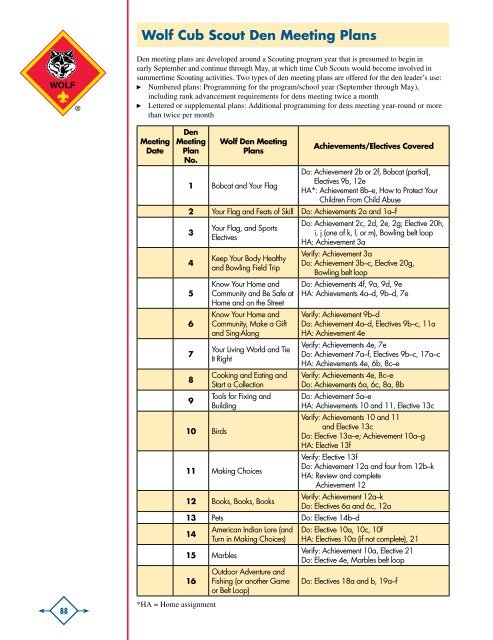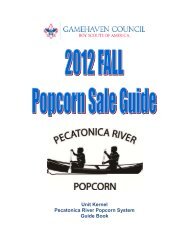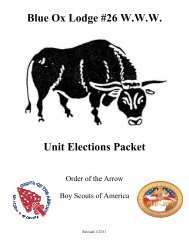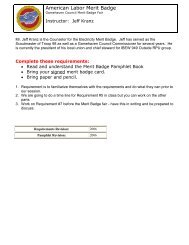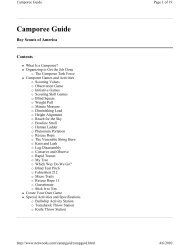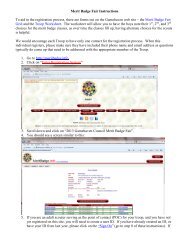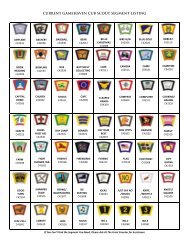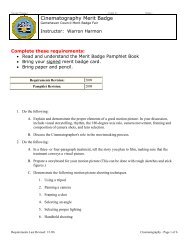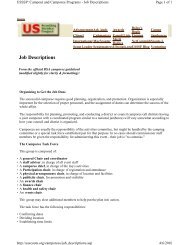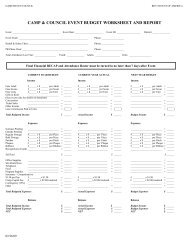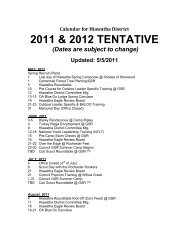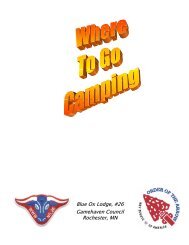Wolf cub scout den Meeting Plans - Gamehaven Council
Wolf cub scout den Meeting Plans - Gamehaven Council
Wolf cub scout den Meeting Plans - Gamehaven Council
You also want an ePaper? Increase the reach of your titles
YUMPU automatically turns print PDFs into web optimized ePapers that Google loves.
ActivitiesReview the Bobcat requirements (pages 16–26 of the <strong>Wolf</strong> Handbook):n Learn and say the Cub Scout Promise.n Say the Law of the Pack and discuss what it means.n Tell what Webelos means. (We’ll Be Loyal Scouts.)n Learn the Cub Scout sign and tell what it means. (Two parts of the Promise: “help otherpeople” and “obey the Law of the Pack,” and it looks like a <strong>Wolf</strong>’s ears, meaning “I’m readyto listen.”)n Show the Cub Scout handshake and tell what it means. (Like the sign, two parts of the Promise.)n Say the Cub Scout motto. (Do Your Best.)n Learn the Cub Scout salute and tell what it means. (Respect)n Suggestion: Bobcat relay race:• The <strong>den</strong> divides into two teams, lining up for relay race on one end of room or field, withleaders and/or parent helpers on the other end, to test on the Cub Scout Promise, Law ofthe Pack, Cub Scout motto, sign, handshake, salute, and meaning of Webelos.• The first boy on each team walks to the leader, answers the Bobcat-related question, thenreturns to tag the next Cub Scout.• If the Cub Scout can’t answer, he can go back and get help from the other Scouts, thenreturn and answer the question.Den <strong>Meeting</strong> 1Complete the Character Connection for Honesty.n Know: Discuss these questions with your family. What is a promise? What does it mean to“keep your word?” What does honesty mean? What does it mean to “do your best?”n Commit: Discuss these questions with your family. Why is a promise important? Why isit important for people to trust you when you give your word? When might it be difficult tokeep your word? List examples.n Practice: Discuss with family members why it is important to be trustworthy and honestand how you can do your best to be honest when you are doing the activities in CubScouting.Elective 9b (“Make a gift or toy like one of these and give it to someone.”):n Photograph each boy separately (head and shoulders) in his uniform. Alternatively, have theScouts photograph each other (serious shots and fun shots).n This will be used for Elective 9b in Den <strong>Meeting</strong> 5.Elective 12e (“Make a stencil pattern.”):n Trace each boy’s hand on cardstock (or heavy paper) and make a stencil.n Then trace the pattern on a square of yellow-gold felt.n Have each boy cut out his handprint and put his name on the back of it.n This will be used for your <strong>den</strong> flag. If you keep the flag in this way, at their Arrow of LightAward ceremony, when the boys are in fifth grade, the handprints can be removed from the<strong>den</strong> flag and each boy will present his print to his parents.ClosingAward (or recognize) any advancement completed at this meeting; thank hosts, guests, and helpers.. Hand out or send family information letter.Home Assignment: Remind parents to complete Achievement 8b–e and readHow to Protect Your Children From Child Abuse: A Parent’s Guide.After the <strong>Meeting</strong>If you’ve changed the sequence of <strong>den</strong> meetings, double-check to make sure you will stilladvance your boys appropriately and check with the Cubmaster to make sure you staycoordinated with the pack.Refreshments: If appropriateCleanup: Recruit enough help to do a good job. Scouts always leave an area as clean, or cleaner,than they found it.Following Den <strong>Meeting</strong> 1, the <strong>den</strong> leader prints each boy’s name on his felt handprint,using fabric paint. When the paint is dry, the leader may sew the handprints onto the <strong>den</strong>flag or may choose to have the boys do the sewing at Den <strong>Meeting</strong> 2.91
Den <strong>Meeting</strong> 2<strong>Wolf</strong> Den <strong>Meeting</strong> 2Your Flag and Feats of SkillAchievement 2. Achievement 1.Preparation and Materials NeededFor meeting 2, you will need:n Cub Scout Promise and Pledge of Allegiance printed on index cards.n Bring a baseball or softball and (optional) baseball gloves for boys to play catch. Foam ballsif indoors.n Bring a narrow board, 4 to 6 feet long (see <strong>Wolf</strong> Handbook, page 39). (Lacking a board, youcould use a curb or a strip on a basketball court, or make a mark with tape.)n Bring tape measure and tape to mark how high and how long.n You may wish to have a small poster with the <strong>den</strong> code of conduct.Note: You may elect either to spread Achievement 1 out over several meetings and spend moretime here on tasks like a <strong>den</strong> flag if you choose. If you do so, make sure your <strong>den</strong> stays onschedule to advance in rank.You may wish to make a small poster with the <strong>den</strong> code of conduct.Before the <strong>Meeting</strong>Make final preparations with assistance from any assistant <strong>den</strong> leader or other parent helper, <strong>den</strong>chief, and/or <strong>den</strong>ner. Organize the space (seating, flags, advancement charts, activity materials,handouts, etc.). If you’re snacking, organize space for that and the cleanup.GatheringHave a gathering activity (games, puzzles, other) that will keep Scouts interested and busy, andthat others may join as they arrive. If the <strong>den</strong> desires, serve a healthy snack during this time.Collect dues, record attendance and any advancement completed at home (a good job for anassistant <strong>den</strong> leader). Assign parents to meeting roles and hand out a meeting plan to each.OpeningConduct a flag ceremony, indoor (Achievement 2b) or outdoor (Achievement 2f). Optionsinclude:n Gather in a line, circle, or square: Pledge of Allegiance; have the Scout leading theceremony tell what the Pledge means (Achievement 2a); Cub Scout Promise or Law of thePack; lead patriotic song.n Note: Lots of ways to do this. Having each Scout recite alone is ideal; using a tape recorderor video recorder to make it fun is also good as long as all are not silly.n Maybe, after each Scout recites, have each add one statement about “what it means”(without, if possible, repeating an earlier comment).n An illuminating exercise is to ask the Scouts to discuss what certain of the words mean.“United,” “republic,” “liberty,” and “justice” may just be sounds or noise to many Scouts atthis age, so this can be a real eye-opener for them.n Rotate leadership of flag ceremonies so each boy has a turn at every role (Achievement 2b).Continue using the index cards printed with the Cub Scout Promise and Pledge of Allegiance.Business ItemsReview the code of conduct for <strong>den</strong> meetings.Verify: Confirm completion of Achievement 8b–c and How to Protect Your Children FromChild Abuse.Use this time to discuss participation in coming pack meetings or events, as needed.92ActivitiesAchievement 1: Feats of Skill Achievements (These can be done with everyone doing the sameactivity at the same time, or as a rotation among different leaders around the meeting space.):n Achievement 1a (“Play catch with someone 10 steps away. Play until you can throw andcatch.”)n Achievement 1b (“Walk a line back and forth. Do it sideways too. Walk the edge of a boardsix steps each way.”)n Achievement 1c (“Do a front roll.”)
nnnAchievement 2d (“Learn about the flag of your state or territory and how to display it.”)• See the state flags on page 50 of the <strong>Wolf</strong> Handbook, and discuss what your flag shows/what other flags show.• Display is subordinate to the U.S. flag (below on a single pole, or to the speaker’s left).Achievement 2e (“Learn how to raise a U.S. flag properly for an outdoor ceremony.”)Achievement 2g (“With the help of another person, fold the U.S. flag.”)• As they practice, it is a good idea to have a third Scout help support the middle of the flag.Den <strong>Meeting</strong> 3Sports Electives (Elective 20):n Elective 20h (“Show how to make a sprint start in track. See how far you can run in 10seconds.”)• Use a stopwatch (or your watch) and tape to mark how far each Scout ran.• Repeat as necessary!n Elective 20i (“Do a standing long jump. Jump as far as you can.”)• Use tape to mark how far each Scout jumped.• Repeat as necessary!n Play a team sport:• Elective 20j (“Play a game of flag football.”)— Elective 20k (“Show how to dribble and kick a soccer ball. Take part in a game.”)— Elective 20l (“Play a game of baseball or softball.”)— Elective 20m (“Show how to shoot, pass, and dribble a basketball. Take part in a game.”)Bowling belt loop, requirement 1 (or for whichever sport you’ll be playing in the nextmeeting). Discuss with the boys the rules of courtesy and safety for bowling. They will need tobe able to tell you about these rules at the next meeting to qualify for the belt loop.ClosingAward (or recognize) any advancement completed at this meeting; thank hosts, guests, and helpers.Closing ceremony: Retire the colors (fold and return the flag), or have a <strong>den</strong> leader’s minutewith a Living Circle, or the Law of the Pack and <strong>den</strong> yell (or other ceremony).Hand out or send family information letter.Home Assignment: Complete and return healthy habits chart (Achievement 3a) intwo weeks.After the <strong>Meeting</strong>If you’ve changed the sequence of <strong>den</strong> meetings, double-check to make sure you will stilladvance your boys appropriately and check with the Cubmaster to make sure you staycoordinated with the pack.Refreshments: If appropriateCleanup: Recruit enough help to do a good job. Scouts always leave an area as clean, or cleaner,than they found it.95
Den <strong>Meeting</strong> 3<strong>Wolf</strong> Cub ScoutsAchievement 3a: Keep Your Body HealthyMark your chart each time you do these things. Name: __________________________________Sun Mon Tues Wed Thu Fri Sat Sun Mon Tues Wed Thu Fri SatBathe or Shower Often; Use Soap(√ for each time)Wash Your Hands (√ for each time)Brush Your Teeth (√ for each time)Drink Lots of Water (√ for each cup)Run and Play Outdoors (howmany minutes)Get the Sleep You Need (howmany hours)96
Den <strong>Meeting</strong> 4<strong>Wolf</strong> Den <strong>Meeting</strong> 4Keep Your Body Healthy and Bowling Field TripAchievement 3. Elective 20g. Bowling Belt Loop (completion).Preparation and Materials NeededConfirm arrangements for Den <strong>Meeting</strong> 4’s trip to the bowling lanes (or other location) are inplace, transportation plans are made, etc.For Den <strong>Meeting</strong> 6, make arrangements for a field trip to your local fire station or anotherimportant place in your community, such as a historic or government location, so find a locationthat is important and interesting, as well as convenient, for your <strong>den</strong> to visit.Request permission to use a meeting room at the fire station or other important place for snacksand to complete additional requirements while at the location.Materials checklist (add to your <strong>den</strong> Cub tub of U.S./<strong>den</strong> flags, paper/pencils, other supplies):n Bring stick-on bandages for the boys to use on a “pretend” cut finger. And a red marker.n (Optional fun) Roll-on cotton gauze and medical tape, plus some red dye.n Belt loops for Bowling (or the sport you pick) to provide “immediate recognition” for each boy.Make arrangements with a bowling alley to bring your <strong>den</strong>.n Provide bowling alley staff with a copy of the Bowling belt loop requirements (see below).n Arrange transportation to the bowling alley.Alternate sport: Try to do bowling if possible. If not, do another sports belt loop.Before the <strong>Meeting</strong>Make final preparations with assistance from any assistant <strong>den</strong> leader or other parent helper, <strong>den</strong>chief, and/or <strong>den</strong>ner. Organize the space (seating, flags, advancement charts, activity materials,handouts, etc.). If you’re snacking, organize space for that and the cleanup.GatheringHave a gathering activity (games, puzzles, other) that will keep Scouts interested and busy, andthat others may join as they arrive. If the <strong>den</strong> desires, serve a healthy snack during this time.Collect dues, record attendance and any advancement completed at home (a good job for anassistant <strong>den</strong> leader). Assign parents to meeting roles and hand out a meeting plan to each.OpeningConduct a flag ceremony, indoor (Achievement 2b) or outdoor (Achievement 2f).Options include:n Gather in a line, circle, or square: Pledge of Allegiance; have the Scout leading theceremony tell what the Pledge means (Achievement 2a); Cub Scout Promise or Law of thePack; lead patriotic song.n Rotate leadership of flag ceremonies so each boy has a turn at every role (Achievement 2b).Business ItemsVerify: Achievement 3a—completed healthy habits chart.Do a general review of rules of courtesy and safety for bowling; cover specific rules for the field trip.Use this time to discuss participation in coming pack meetings or events, as needed.ActivitiesElective 20g: Go bowling. The Bowling belt loop can be earned. Requirements are:1. Explain to your leader or adult partner the rules of courtesy and safety for bowling.2. Show how to pick out a ball of proper weight and with finger holes that fit your hand.3. Play a complete game with your family or <strong>den</strong>.• Use the down time between throws to have each boy explain to the <strong>den</strong> leader or adultthe rules of courtesy and safety for bowling.98Achievements 3b (“Tell four ways to stop the spread of colds.”) Complete these while the boysare awaiting their turn at bowling, or while taking a break from another sport. Give each boy theopportunity to explain to the <strong>den</strong> leader or parent helper four ways to stop the spread of colds: Stayaway from others if you have a cold or flu; get lots of rest, drink liquids; turn away when sneezing(use a handkerchief, use your elbow); wash your hands often, and always after you sneeze.
nnnnAchievement 3c: (“Show what to do for a small cut on your finger.”):1. Tell a grown-up. If it is a big cut, get help fast.2. Let it bleed out a little (to clear dirt and germs).3. Wash with soap and water.4. Put on a stick-on bandage.Let each boy demonstrate to the <strong>den</strong> leader or a parent helper how to use a stick-on bandageon a pretend cut.Use the red marker to make a “cut” on a finger. Make it small enough to fit under thebandage and to obviously be a “small cut,” probably less than a half-inch long.Then go through the steps above. The red marker makes a big difference. The kids are prettyserious and careful about their “cut.”Den <strong>Meeting</strong> 4Want More Fun Activities?Note: For maximum fun, as the bowling ends, in addition to the Band-Aids, put largerbandages on the boys, using the roll on cotton gauze and medical tape, then add reddye. Be sure to prep the boys to be brave when they are picked up by the parents! Butmake sure they quickly explain that the bandages are just for practice and that their kidsweren’t injured!ClosingAward (or recognize) any advancement completed at this meeting; thank hosts, guests, and helpers.n Award the belt loop in a manner customary to your pack (ask your Cubmaster if you areunsure). Some packs explain to boys that they will receive their Bowling belt loop at thenext pack meeting, others give it as immediate recognition and still recognize them at thepack meeting.Closing ceremony: Retire the colors (fold and return the flag) or have a <strong>den</strong> leader’s minute witha Living Circle, or the Law of the Pack and <strong>den</strong> yell (or other ceremony).Hand out or send family information letter.After the <strong>Meeting</strong>If you’ve changed the sequence of <strong>den</strong> meetings, double-check to make sure you will stilladvance your boys appropriately and check with the Cubmaster to make sure you staycoordinated with the pack.Refreshments: If appropriateCleanup: Recruit enough help to do a good job. Scouts always leave an area as clean, or cleaner,than they found it.99
Introduce the concept of home safety in preparation for your Cub Scouts completingAchievement 9b and c at home (home safety rules):n Achievement 9b (“With an adult, check your home for hazards and know how to make yourhome safe.”), and 9c (“With an adult, check your home for danger from fire.”)n You can start in your <strong>den</strong> meeting location and make a list of things that should bemaintained or changed to keep everyone safe. The adult can make the list as the Cubs pointout safety items.n The <strong>Wolf</strong> Handbook specifically mentions several items at pages 83–84, such as knowingwhere the water shutoff and circuit breaker box are. Check the gas shutoff, too, if you havenatural gas service.n Basic safety information makes a big difference in an emergency. Do you know where thefire extinguishers are at your workplace? At your <strong>den</strong> and pack meeting places? Help yourCubs by pointing out emergency exits and fire extinguishers on field trips.Den <strong>Meeting</strong> 5ClosingAward (or recognize) any advancement completed at this meeting; thank hosts, guests, and helpers.Closing ceremony: Retire the colors (fold and return the flag), or have a <strong>den</strong> leader’s minutewith a Living Circle, or the Law of the Pack and <strong>den</strong> yell (or other ceremony).Hand out or send family information letter.Home Assignments:n Ask parents to help Cub Scouts complete Achievements 9b, 9c, 9d; and 4b,4c, and 4d. Ask them to help Cub Scouts find articles for Achievement 7e toshare at the next <strong>den</strong> meeting.n Boys should practice the rules of bike safety before the next meeting (9e) and havea family member sign off in their handbook. Hand out the bike safety quiz at the endof this meeting plan as a resource to help teach Scouts and parents.After the <strong>Meeting</strong>If you’ve changed the sequence of <strong>den</strong> meetings, double-check to make sure you will stilladvance your boys appropriately and check with the Cubmaster to make sure you staycoordinated with the pack.Refreshments: If appropriateCleanup: Recruit enough help to do a good job. Scouts always leave an area as clean, or cleaner,than they found it.101
Den <strong>Meeting</strong> 5Bike Safety QuizA bicycle is not a toy . . . it is a vehicle and you are the driver!Learn to share the road and Ride Safely.1. Are there any times when you don’t need to wear a helmet when riding a bike?Answer:______________________________________________________________________2. Name three safe bike riding practices:Answers:_______________________________________________________________________________________________________________________________________________________________________________________________________________________________3. What kinds of things should you check before you begin to ride?Answer: _ ____________________________________________________________________4. Where do most bicycle crashes occur?Answer:______________________________________________________________________5. When riding your bike, it is important to stay alert at all times. Name three road hazardsyou should watch out for:Answers:_______________________________________________________________________________________________________________________________________________________________________________________________________________________________6. Is it OK to ride a bicycle while listening to audio headphones?Answer:______________________________________________________________________7. What is the most serious type of injury for cyclists?Answer: _ ____________________________________________________________________8. Always be a courteous cyclist. Remember, who has the right of way? Cyclists or pedestrians?Answer: _ ____________________________________________________________________9. How do you finish this sentence? Be Safe, Be ________! Sore or Seen?Answer:______________________________________________________________________10. Always go with the flow of traffic, and stay to which side of the road?Answer:______________________________________________________________________11. Before entering a roadway, you should look which ways for traffic?Answer: _ ____________________________________________________________________12. Where do you always need to check before changing lanes?Answer:______________________________________________________________________13. Your bicycle helmet should cover your what?Answer:______________________________________________________________________14. Your bicycle helmet should fit how?Answer:______________________________________________________________________15. When making a turn, what do you do for others?Answer:______________________________________________________________________102
Bike Safety Quiz AnswersA bicycle is not a toy . . . it is a vehicle and you are the driver!Learn to share the road and Ride Safely.Den <strong>Meeting</strong> 51. Are there any times when you don’t need to wear a helmet when riding a bike?Answer: No, you should wear a helmet every time you get on any bike.2. Name three safe bike riding practices:Answers include:a. Ride single file.b. Obey traffic signs, signals, and lane markings.c. Always ride on the right side of the road, with traffic.d. Signal your moves to others.e. Check for traffic at an intersection.f. Stay alert at all times; slow down at driveways.g. ________________3. What kinds of things should you check before you begin to ride?Answers:a. Inflate your tires properly.b. Check your brakes before riding.c. Always wear bright colors.d. Make sure you’re not wearing clothes that can get caught in your bike.e. Carry your books and other possessions in a bicycle carrier or backpack.4. Where do most bicycle crashes occur?Answer: At intersections, including driveways.5. When riding your bike, it is important to stay alert at all times. Name three road hazardsyou should watch out for.Answers: Potholes, wet leaves, storm grates, cracks, gravel, broken glass or trash, water or oil,parked cars (doors flying open), ______________6. Is it OK to ride a bicycle while listening to audio headphones?Answer: No.7. What is the most serious type of injury for cyclists?Answer: Head injuries.8. Always be a courteous cyclist. Remember, who has the right of way? Cyclists or pedestrians?Answer: Pedestrians.9. How do you finish this sentence? Be Safe, Be ___________! Sore or Seen?Answer: Be Safe, Be Seen!10. Always go with the flow of traffic, and stay to which side of the road?Answer: The right side of the road.11. Before entering a roadway, you should look which ways for traffic?Answer: Left-right-left.12. Where do you always need to check before changing lanes?Answer: Beside you, in front of you, and behind you!13. Your bicycle helmet should cover your what?Answer: Forehead and the top of your head.14. Your bicycle helmet should fit how?Answer: Snugly, all straps snug and attached.15. When making a turn, what do you do for others?Answer: Signal your turn; show right and left turn signals.103
Den <strong>Meeting</strong> 6<strong>Wolf</strong> Den <strong>Meeting</strong> 6Know Your Home and Community, Make a Gift, and Sing-AlongAchievement 4. Elective 9b. Elective 11a.Preparation and Materials NeededMaterials checklist (add to your <strong>den</strong> Cub tub of U.S./<strong>den</strong> flags, paper/pencils, other supplies):n Bring the photographs of the boys that were taken at the first <strong>den</strong> meeting.n Picture frames to be decoratedn Paint and brushes or other materials to decorate the framesn Smocks (or old shirts large enough to fit over the boys) to protect the uniforms from paintn Index cards (for important phone numbers)n Prepare permission slips for a field trip to a fire station or other important place for <strong>Meeting</strong> 6.Before the <strong>Meeting</strong>Make final preparations with assistance from any assistant <strong>den</strong> leader or other parent helper, <strong>den</strong>chief, and/or <strong>den</strong>ner. Organize the space (seating, flags, advancement charts, activity materials,handouts, etc.). If you’re snacking, organize space for that and the cleanup.GatheringHave a gathering activity (games, puzzles, other) that will keep Scouts interested and busy, andthat others may join as they arrive. If the <strong>den</strong> desires, serve a healthy snack during this time.Collect dues, record attendance and any advancement completed at home (a good job for anassistant <strong>den</strong> leader). Assign parents to meeting roles and hand out a meeting plan to each.OpeningConduct a flag ceremony, indoor (Achievement 2b) or outdoor (2f). Options include:n Gather in a line, circle, or square: Pledge of Allegiance; have the Scout leading theceremony tell what the Pledge means (Achievement 2a); Cub Scout Promise or Law of thePack; lead patriotic song.n Rotate leadership of flag ceremonies so each boy has a turn at every role (Achievement 2b).Business ItemsVerify: Achievement 9b–9d based on boys’ handbooks.Use this time to discuss participation in coming pack meetings or events, as needed.ActivitiesYou might want to do two or more of these as stations, and rotate pairs of kids through them. Boysand their families will have worked on these at home, but this is a chance for the boys to practice.Achievement 4a (“Make a list of phone numbers you need in case of an emergency. Put a copy ofthis list by each phone or in a central place in your home. Update it often.”) Check for:• Police• Sheriff• Fire department• Doctor• Ambulance service• Adult family member(s) at work• Relatives• Neighbors• Othersn Consider having them keep some numbers (family home, work, cell numbers) on a card theykeep with them if they have not memorized those numbers. Use the index cards you brought.Achievement 4b (“Tell what to do if someone comes to the door and wants to come in.”):n Using another adult leader, have each Scout practice that.n But do not replicate a horror movie. Just be normal and encourage normal response.104
Den <strong>Meeting</strong> 6Achievement 4e: Talk with your family members. Agree on the household jobs you will be responsible for.Make a list of your jobs and mark off when you have finished them. Do this for one month.Mark your chart each time you do these things. Name: __________________________________Chore Sun Mon Tues Wed Thu Fri Sat Sun Mon Tues Wed Thu Fri Sat______________________________________________________________________________________________________________________________________________________________________________106
n Among many references to the Good Turn in BSA literature is this comment from the BoyScout Handbook: “To people who know about Scouting, the daily Good Turn is one of thefinest features of our movement. The record of Good Turns, small and large, that have beendone by Scouts since the day Scouting was founded is truly impressive.”n Good Turn for America is a national call to service by the Boy Scouts of America to helpprovide adequate food and shelter and to develop good health habits in the nation.n To address these issues, the BSA is collaborating with some of the most respected serviceorganizations working in each of these areas.n More at www.goodturnforamerica.orgUse this time to discuss participation in coming pack meetings or events, as needed.Den <strong>Meeting</strong> 7ActivitiesDiscuss Achievements 7a, 7b, 7c, 7e, and 7f.n Some of these you might want to complete as breaks during the cleanup project later inthe meeting.Achievement 7a (“Complete the Character Connection for Respect.”):n Know: Discuss these questions with your family: What things have people done to showa lack of respect to our world? Why is it important to respect our environment and naturalresources? How can you show respect for your environment?n Commit: Discuss with your family how you feel when you see places in your neighborhoodthat have lots of litter. Name one thing you can do to help the environment. “n Practice: Practice being respectful while doing the requirements for “Your Living World.”Achievement 7b (“Land, air, and water can get dirty. Discuss with your family ways thiscan happen.”)Achievement 7c (“It takes a lot of energy to make glass, cans, and paper products. You can helpsave energy by collecting these items for use again. Find out how recycling is done where youlive. Find out what items you can recycle.”)Achievement 7e (“With an adult, find three stories that tell how people are protecting our world.Read and discuss them together.”)n Have each boy tell about the three stories he found on how people are protecting our world.Achievement 7f (“Besides recycling, there are other ways to save energy. List three ways youcan save energy, and do them.”)Achievement 7d (“With an adult, pick up litter in your neighborhood. Wear gloves to protectyour hands against germs and cuts from sharp objects.”)n Go outdoors to pick up litter around your meeting place.n Be sure to separate recyclable stuff.n Hints: Find a way to make it fun:• A contest (divide the <strong>den</strong> to award by volume or number of items, or number ofrecyclables, or something),• Or a scavenger hunt (check out the area to create your list of things they could find),• Or do a full cleanup treasure hunt (see Tiger Den <strong>Meeting</strong> 16).n Use breaks to allow for rest and to conduct or complete the Achievement 7a, 7b, 7c, and 7ediscussions. (They may have thought of new things while doing the cleanup!) See above.n Wash hands and/or use hand sanitizer when complete.Elective 9b–c (“Make a gift or toy like one of these and give it to someone”):n Wearing smocks, have each boy decorate the picture frame created in Den <strong>Meeting</strong> 6, thenwrap it and tie it with string (to complete Elective 17b and c).109
Den <strong>Meeting</strong> 7Do Electives 17a, 17b, and 17c: (Learn two knots and how to tie a package.)n 17a (“Learn to tie an overhand knot and a square knot.”)• The overhand knot can be used temporarily but unties very easily if tied around something.• The overhand knot can be used as a stopper knot and can keep a rope from frayingor unraveling.• To tie an overhand knot: Make a loop in your rope and put an end of the rope through it.• The square knot is also known as the joining knot because it can join two ropes togetherand because it is the first knot Scouts learn when they join the BSA. It has many uses,from securing bundles, packages, and the sails of ships to tying the ends of bandages.• To tie a square knot: Hold one rope end in each hand.— Pass the right end over and under the rope in your left hand . . . and pull it snug (nowyou’re holding that end with your left hand, and you’ve switched the other to your right).— Next, pass that same end of the rope (the one that is now in your left hand) over andunder the one that is now in your right hand . . . and pull it tightly snug.— Remember: right over left, left over right.— Note: http://meritbadge.org/wiki/index.php/Knots includes animation to show you how.n Elective 17b (“Tie your shoelaces with a square bow knot.”)n Elective 17c (“Wrap and tie a package so that it is neat and tight.”)• Have the boys wrap the framed photos made at Den <strong>Meeting</strong> 5, take them home, andgive them to their parents as gifts.n Note: Electives 17b and 17c can be completed as part of Electives 9b and 9c.ClosingAward (or recognize) any advancement completed at this meeting; thank hosts, guests,and helpers.Closing ceremony: Retire the colors (fold and return the flag), or have a <strong>den</strong> leader’s minutewith a Living Circle, or the Law of the Pack and <strong>den</strong> yell (or other ceremony).Hand out or send family information letter.Home Assignments:n Remind boys that their list of household chores completed is due at the next <strong>den</strong>meeting (Achievement 4e).n Boys are to begin a collection starting with 10 items and arranging them neatly(Achievement 6b). Start by collecting 10 things and arranging them neatly.Each boy is to bring his collection to the next <strong>den</strong> meeting to show the <strong>den</strong>.(Option: you can spread this out so everyone has more time to show and tell abouttheir collection.)n Ask the parents to have the boys complete Achievements 8c–e (Cooking andeating) at home.Boys who have attended all <strong>den</strong> meetings and completed home assignments will nowqualify for the Cub Scout Immediate Recognition Emblem and their first yellow ProgressToward Ranks bead (for completing Achievements 1, 3, and 9). These should bepresented at the <strong>den</strong> meeting.Explain to the boys that every time they complete three achievements, they receive a yellowbead. After they earn four yellow beads, then they will have earned their <strong>Wolf</strong> badge.110
After the <strong>Meeting</strong>If you’ve changed the sequence of <strong>den</strong> meetings, double-check to make sure you will stilladvance your boys appropriately and check with the Cubmaster to make sure you staycoordinated with the pack.Refreshments: If appropriateCleanup: Recruit enough help to do a good job. Scouts always leave an area as clean, or cleaner,than they found it.Den <strong>Meeting</strong> 7111
Den <strong>Meeting</strong> 8<strong>Wolf</strong> Den <strong>Meeting</strong> 8Cooking and Eating and Start a CollectionAchievement 8. Achievement 6.Preparation and Materials NeededMaterials checklist (add to your <strong>den</strong> Cub tub of U.S./<strong>den</strong> flags, paper/pencils, other supplies):n Bring a U.S. flag and the <strong>den</strong> flag, and enough paper and pencils for each boy.n Bring “Food Pyramid” handouts. Go to www.mypyramid.gov to check that out.You can create personal pyramids at www.mypyramid.gov/mypyramid/index.aspx, tailored toyour size, age, and activity level. Access to a computer with Internet access in this meetingwould be an excellent way to research this with Scouts.n Bringing samples of food in each food group would also be a great idea and a good snack.For example, whole grain bread and crackers, some broccoli and carrots, fresh fruit of yourchoice, a variety of nuts (check for allergies), milk and cheese, hard boiled eggs. And water.n If you’re doing a field trip, prepare permission slips for the field trip at Den <strong>Meeting</strong> 9.n Beads for Cub Scout Immediate Recognition EmblemsBefore the <strong>Meeting</strong>Make final preparations with assistance from any assistant <strong>den</strong> leader or other parent helper, <strong>den</strong>chief, and/or <strong>den</strong>ner. Organize the space (seating, flags, advancement charts, activity materials,handouts, etc.). If you’re snacking, organize space for that and the cleanup.GatheringHave a gathering activity (games, puzzles, other) that will keep Scouts interested and busy, andthat others may join as they arrive. If the <strong>den</strong> desires, serve a healthy snack during this time.Collect dues, record attendance and any advancement completed at home (a good job for anassistant <strong>den</strong> leader), especially check handbooks for completion of Achievements 8c, 8d, and 8e.Assign parents to meeting roles and hand out a meeting plan to each.OpeningConduct a flag ceremony, indoor (Achievement 2b) or outdoor (Achievement 2f).Options include:n Gather in a line, circle, or square. Pledge of Allegiance; have the Scout leading theceremony tell what the Pledge means (Achievement 2a); Cub Scout Promise or Law of thePack; lead patriotic song.n Rotate leadership of flag ceremonies so each boy has a turn at every role (Achievement 2b).Business ItemsVerify Achievement 4e and Achievement 8c–e using the boys’ handbooks. Collect from eachCub Scout a list of household chores he has completed in the last month.Use this time to discuss participation in coming pack meetings or events, as needed.ActivitiesAchievement 8a: (“Study the Food Guide Pyramid. Name some foods from each of the foodgroups shown in the pyramid.”) See page 79 of the <strong>Wolf</strong> Handbook.n Discuss the Food Guide Pyramid. Name foods from each of the food groups shown there:grains, vegetables, fruits, fats/sugar/salt (sodium), milk, protein (meat/beans).• You could conduct it as “Food Pyramid Scholar Bowl Quiz Show”:— Split the <strong>den</strong> into two teams. Pick a food group, and ask each team to namesomething that is in that group. Alternate between teams, keeping score.— Or give them a food and have them determine which group(s) it is in.n Ideally, as you discuss each one, you snack on something from each of the food groups!n Also, you can ask them to i<strong>den</strong>tify the food groups in common meals, like macaroni andcheese, pizza, tacos, hamburgers, peanut butter and jelly sandwich, or breakfast cereal.112
Achievement 8b (“Plan the meals you and your family should have for one day. List things yourfamily should have from the food groups shown in the food group pyramid. At each meal, youshould have foods from at least three food groups.”)n These can be take-home plans for family cooking, but if you will be doing a pack campout orother outing, and cooking or eating at it, you can make that menu planning part of this meeting!n Or use it for snack planning for the rest of the year to cut down on poor snack offerings!Den <strong>Meeting</strong> 8Achievement 6a: Complete the Character Connection for Positive Attitude.n Know: Discuss with your family how a cheerful and positive attitude will help you do yourbest at school and in other areas of your life.n Commit: Discuss with your family how gathering items for a collection may be difficult.How does a hopeful and cheerful attitude help you to keep looking for more items? Why isa positive attitude important?n Practice: Practice having a positive attitude while doing Achievement 6: Start a Collection.Achievement 6c (“Show and explain your collection to another person.”):n Have each boy bring his collection to the <strong>den</strong> meeting and show his collection to the <strong>den</strong>.Want More Fun Activities?This meeting may need a dose of Feats of Skill or games for active fun!Be ready, if you sense it is dragging, to pull out a quick game or quick set of Feats of Skill.Other Suggestions: Pick a game or relay from any of those provided throughout this guide.ClosingAward (or recognize) any advancement completed at this meeting; thank hosts, guests, and helpers.Closing ceremony: Retire the colors (fold and return the flag), or have a <strong>den</strong> leader’s minutewith a Living Circle, or the Law of the Pack and <strong>den</strong> yell (or other ceremony).Hand out permission slips for a field trip to a hardware store/lumberyard if you’re doing a field trip.Hand out or send family information letter.Boys who have attended all <strong>den</strong> meetings and completed home assignments now qualifyfor their second yellow Progress Toward Ranks bead (for completing Achievements 4, 6,and 7).After the <strong>Meeting</strong>If you’ve changed the sequence of <strong>den</strong> meetings, double-check to make sure you will stilladvance your boys appropriately and check with the Cubmaster to make sure you staycoordinated with the pack.Refreshments: If appropriateCleanup: Recruit enough help to do a good job. Scouts always leave an area as clean, or cleaner,than they found it.113
Den <strong>Meeting</strong> 9<strong>Wolf</strong> Den <strong>Meeting</strong> 9Tools for Fixing and BuildingAchievement 5.Power tools are not appropriate for use by Cub Scouts, review the use of age-appropriatetools for Cub Scouts in the Cub Scout Leader How-To Book and Age-Appropriate Guidelinesfor Scouting.Preparation and Materials NeededFor Den <strong>Meeting</strong> 9, make arrangements for a field trip to your local hardware store or lumberyardor local woodworker (your pack may have ideas about who has safe woodworking tools; charteredorganization maintenance or facilities personnel may be willing to assist).n Discuss Achievement 5 requirements with the staff, ask for help from the staff when you visit.n Determine if the store will permit the boys to build bookends (or a birdhouse (see <strong>Meeting</strong>10) or other suitable alternative wood project) at the store, and if there is adequate space toconduct such activity safely. If the store manager grants permission, then bring wood for theproject and enough hammers, saws, nails, and safety glasses for each boy.n Power tools are not appropriate for use by Cub Scouts. Review the use of age- appropriatetools for Cub Scouts in the Cub Scout Leader How-To Book and Age-AppropriateGuidelines for Scouting activities (www.<strong>scout</strong>ing.org/HealthandSafety/Resources/Age-AppropriateGuidelines).Materials checklist (add to your <strong>den</strong> Cub tub of U.S./<strong>den</strong> flags, paper/pencils, other supplies):n Seven or more tools. Must have pliers, Philips head screwdriver, standard screwdriver, andhammer. Lightweight hammers are a very good idea (many second-graders cannot swing a16-oz. hammer accurately).n Both Philips head and standard screws, and nailsn Boards for nailing and screws (and removal of nails and screws)n Boards or kits to make something useful (For example, birdhouse, bookends or a suitablealternative wood project. A pinewood derby car is useful, right?)n Safety glasses and first-aid kitBefore the <strong>Meeting</strong>Make final preparations with assistance from any assistant <strong>den</strong> leader or other parent helper, <strong>den</strong>chief, and/or <strong>den</strong>ner. Organize the space (seating, flags, advancement charts, activity materials,handouts, etc.). If you’re snacking, organize space for that and the cleanup.GatheringHave a gathering activity (games, puzzles, other) that will keep Scouts interested and busy, andthat others may join as they arrive. If the <strong>den</strong> desires, serve a healthy snack during this time.Collect dues, record attendance and any advancement completed at home (a good job for anassistant <strong>den</strong> leader). Assign parents to meeting roles and hand out a meeting plan to each.If you’re on a field trip, as boys arrive, collect permission slips from parents who are not staying.OpeningConduct a flag ceremony, indoor (Achievement 2b) or outdoor (Achievement 2f).Options include:n Use the store’s employees to participate (they may help you get a good temporary flagpole).n Gather in a line, circle, or square. Pledge of Allegiance; have the Scout leading theceremony tell what the Pledge means (Achievement 2a); Cub Scout Promise or Law of thePack; lead patriotic song.n Rotate leadership of flag ceremonies so each boy has a turn at every role (Achievement 2b).Business ItemsUse this time to discuss participation in coming pack meetings or pack events, as needed.114
Den <strong>Meeting</strong> 10<strong>Wolf</strong> Den <strong>Meeting</strong> 10BirdsElective 13. Achievement 10. Achievement 11. character Connection for Cooperation.Character Connection for Faith.Preparation and Materials NeededFor Den <strong>Meeting</strong> 10, bring a bird-watching chart (see <strong>Wolf</strong> Den <strong>Meeting</strong> 10) for each boy, and abook about birds with lots of drawings (ask your public librarian for assistance in i<strong>den</strong>tifying asuitable book for second-graders).Determine if any of the boys is allergic to peanuts. If no one is allergic to peanuts, thenprepare materials for a pinecone bird feeder (one large pinecone per boy, string, jar of peanutbutter, birdseed, an 8-by-8-inch cake pan, plastic knives, newspaper to cover the work table, asmock for each boy and adult, and quart-size plastic zipper bags labeled with the name of eachboy to hold each completed pinecone bird feeder). Research on the Internet instructions forpinecone bird feeders; instructions are readily available online.nIf peanut allergies are a problem, then make a bird feeder as shown in the <strong>Wolf</strong> Handbook,page 176, or make one from a recyclable plastic milk jug or two-liter soda bottle.Make up or purchase a birdhouse kit for each boy.Gather some books about birds for loan to boys who do not complete Elective 13c at home.Before the <strong>Meeting</strong>Make final preparations with assistance from any assistant <strong>den</strong> leader or other parent helper, <strong>den</strong>chief, and/or <strong>den</strong>ner. Organize the space (seating, flags, advancement charts, activity materials,handouts, etc.). If you’re snacking, organize space for that and the cleanup.GatheringHave a gathering activity (games, puzzles, other) that will keep Scouts interested and busy, andthat others may join as they arrive. If the <strong>den</strong> desires, serve a healthy snack during this time.Collect dues, record attendance and any advancement completed at home (a good job for anassistant <strong>den</strong> leader), especially check handbooks for completion of Achievements 10 and 11(home assignments).Assign parents to meeting roles and hand out a meeting plan to each.OpeningConduct a flag ceremony, indoor (Achievement 2b) or outdoor (Achievement 2f). Optionsinclude:n Gather in a line, circle, or square. Pledge of Allegiance; have the Scout leading theceremony tell what the Pledge means (Achievement 2a); Cub Scout Promise or Law of thePack; lead patriotic song.n Rotate leadership of flag ceremonies so each boy has a turn at every role (Achievement 2b).Business Items:Verify completion of Achievements 10a–g and 11a–d and Elective 13c using theboys’ handbooks.Elective 13c (“Read a book about birds.”) (home assignment):n A family member should sign off in the boy’s handbook when the requirement is completed.n But go ahead and have boys share information that they learned from reading a book about birds.Use this time to discuss participation in coming pack meetings or events, as needed.ActivitiesElective 13a (“Make a list of all the birds you saw in a week and tell where you saw them (field,forest, marsh, yard, or park).”)n Go outside now for a hike and to see what birds you can see (or hear, or find evi<strong>den</strong>ce of)outside your meeting area as you do these next activities.n Consider fun ways to do this. For example, don’t just say “Let’s go watch birds,” but make ita bird safari, and channel your best Animal Planet sense of wonder and danger.n Or sing a bird song.116
Elective 13d (“Point out 10 different kinds of birds (five may be from pictures).”):n Show the bird pictures on page 174 of the <strong>Wolf</strong> Handbook and ask the boys which of thosethey have seen. Ask boys to name at least two more species they have seen.Den <strong>Meeting</strong> 10Elective 13a (“Make a list of all the birds you saw in a week and tell where you saw them (field,forest, marsh, yard, or park).”):n Distribute a bird-watching chart (at the end of this <strong>den</strong> meeting plan) to each boy (modifythe chart as needed to include local birds), to be completed and returned at the next meeting.Return inside if you like, and do Elective 13e (“Feed wild birds and tell which birds you fed.”)by making pinecone bird feeders.n Have each person put on a smock. Cover the work table with newspaper.n Each boy receives a pinecone and a dull knife.n Place two or three bowls of peanut butter on the table.n Using the dull knife, each boy spreads peanut butter all over the pinecone.n Put birdseed into an 8-by-8-inch pan and roll each peanut butter–coated pinecone in the birdseed.n Place each completed bird feeder into a labeled plastic zipper bag.n Wash hands. Remove smocks.n Remind the boys to hang the bird feeders from a tree or bush when they get home, or do it atthe meeting site if you like.Elective 13f (“Put out a birdhouse and tell which birds use it.”):n Ask the boys to assemble the birdhouse at home and put it out in their yard or neighborhoodand record which birds use it.n Ask family members to sign their handbook after they observe which birds use it.Achievement 10a: Complete the Character Connection for Cooperation.n Know: Discuss these questions with your family: What is “cooperation”? Why do peopleneed to cooperate when they are doing things together? Name some ways that you can behelpful and cooperate with others.n Commit: Discuss with your family what makes it hard to cooperate. How do listening,sharing, and persuading help us cooperate?n Practice: Practice being cooperative while doing the requirements for Family Fun.Achievement 10b: Make a game like one of these. Play it with your family. (Eagle Golf,Beanbag Archery.)Achievement 10c: Plan a walk. Go to a park or a wooded area, or visit a zoo or museum withyour family.Achievement 10d: Read a book or Boys’ Life magazine with your family. Take turns reading aloud.Achievement 10e: Decide with Akela what you will watch on television or listen to on the radio.Achievement 10f: Attend a concert, a play, or other live program with your family.Achievement 10g: Have a family Board Game night at home with members of your family.ClosingAward (or recognize) any advancement completed at this meeting; thank hosts, guests, and helpers.Closing ceremony: Retire the colors (fold and return the flag), or have a <strong>den</strong> leader’s minutewith a Living Circle, or the Law of the Pack and <strong>den</strong> yell (or other ceremony).Hand out or send family information letter.Home Assignment: Ask family members to help put out the birdhouse and observewhich birds use it (Elective 13f). Fill out the bird-sighting chart (Elective 13a) to do so.Boys who have attended all <strong>den</strong> meetings and completed required home assignments willnow qualify for a third yellow Progress Toward Ranks bead to be placed on their CubScout Immediate Recognition Emblem (for completing Achievements 5, 8, and 10).117
Den <strong>Meeting</strong> 10After the <strong>Meeting</strong>If you’ve changed the sequence of <strong>den</strong> meetings, double-check to make sure you will stilladvance your boys appropriately and check with the Cubmaster to make sure you staycoordinated with the pack.Refreshments: If appropriateCleanup: Recruit enough help to do a good job. Scouts always leave an area as clean, or cleaner,than they found it.SparrowRobinGooseSeagullDuckGoldfinch118Blue jayCardinal
Name: ________________________________________________Den <strong>Meeting</strong> 10<strong>Wolf</strong> Cub ScoutsElective 13a: Bird-Sighting ChartType of bird Location Number of sightingsCardinalRobinSparrowGoosePlease bring your completed sheet to the next meeting on _______________.Type of bird Location Number of sightingsDuckGoldfinchBlue jaySeagullRemember to “do your best” to correctly record your information.Type of bird Location Number of sightings119
Den <strong>Meeting</strong> 11<strong>Wolf</strong> Den <strong>Meeting</strong> 11Making ChoicesAchievement 12.Preparation and Materials NeededFor Den <strong>Meeting</strong> 11, remind boys to bring their <strong>Wolf</strong> Handbook.Materials checklist (add to your <strong>den</strong> Cub tub of U.S./<strong>den</strong> flags, paper/pencils, other supplies):nnBoys will need their handbooks.If you want to do this as puppet theater, you’ll need to bring paper lunch bags, markers orcrayons, glue, string. Could bring felt pieces, buttons, stickers.Note: You can also do some of these Making Choices discussions in earlier meetings and spaceit out over the year.Before the <strong>Meeting</strong>Make final preparations with assistance from any assistant <strong>den</strong> leader or other parent helper, <strong>den</strong>chief, and/or <strong>den</strong>ner. Organize the space (seating, flags, advancement charts, activity materials,handouts, etc.). If you’re snacking, organize space for that and the cleanup.GatheringHave a gathering activity (games, puzzles, other) that will keep Scouts interested and busy, andthat others may join as they arrive. If the <strong>den</strong> desires, serve a healthy snack during this time.Collect dues, record attendance and any advancement completed at home (a good job for an assistant<strong>den</strong> leader), especially collect bird-watching charts from the previous meeting (Elective 13a).Assign parents to meeting roles and hand out a meeting plan to each.OpeningConduct a flag ceremony, indoor (Achievement 2b) or outdoor (Achievement 2f). Optionsinclude:n Gather in a line, circle, or square. Pledge of Allegiance; have the Scout leading theceremony tell what the Pledge means (Achievement 2a); Cub Scout Promise or Law of thePack; lead patriotic song.n Rotate leadership of flag ceremonies so each boy has a turn at every role (Achievement 2b).Business ItemsUse this time to discuss participation in coming pack meetings or pack events, as needed.Verify: Check completion of Elective 13f by checking the boys’ handbooks.ActivitiesAchievement 12a: Complete the Character Connection for Courage.n Know: Discuss with your family what courage is. Review the requirements and discuss howyou might need courage in each one to do what is right.n Commit: Give some examples of when it is hard to do the right thing. Discuss with yourfamily times that it might take courage to be honest and kind. Tell about a time in your lifewhen you needed to be brave and courageous to do the right thing.n Practice: Practice learning about courage while doing the requirements for Making Choices.With family members, act out the choices you would make for some of the requirements.Want More Fun Activities?This meeting is all talk, so, consider how to be active:Option: you can do the acting out with puppets, and have this be a puppet theater day.Make simple paper lunch bag hand puppets with markers/crayons, and string and glue.But be sure that after the theater, everyone discusses the issues seriously.Also, there is nothing wrong with mixing up the Making Choices discussion with someactivity, like an obstacle course or game segment. (Complete a section of the courseor game, then discuss. Repeat.)120
nDiscuss the following scenarios and have the boys act out the choices they would make foreach. Cover as many of the following as time permits, but at least four, allowing each boy tocomplete at least one.• Achievement 12b: There is an older boy who hangs around Jason’s school. He tries togive drugs to the children. What would you do if you were Jason?• Achievement 12c: Lee is home alone. The phone rings. When Lee answers, a strangerasks if Lee’s mother is home. She is not. Lee is alone. What would you do if youwere Lee?• Achievement 12d: Justin is new to your school. He has braces on his legs and walkswith a limp. Some of the kids at school tease him. They want you to tease him, too. Whatwould you do?• Achievement 12e: Juan is on a walk with his little sister. A car stops and a man asksthem to come over to the car. What would you do if you were Juan?• Achievement 12f: Matthew’s grandmother gives him money to buy an ice cream cone.On the way to the store, a bigger boy asks for money and threatens to hit Matthew if hedoes not give him some money. If you were Matthew, what would you do?• Achievement 12g: Chris and his little brother are home alone in the afternoon. A womanknocks on the door and says she wants to read the meter. She is not wearing a uniform.What would you do if you were Chris?• Achievement 12h: Sam is home alone. He looks out the window and sees a man tryingto break into a neighbor’s back door. What would you do if you were Sam?• Achievement 12i: Mr. Palmer is blind. He has a guide dog. As he is crossing the street,some kids whistle and call to the dog. They want you and your friends to call the dog,too. What would you do?• Achievement 12j: Some kids who go to Bob’s school want him to steal candy and gumfrom a store, which they can share later. Bob knows this is wrong, but he wants to bepopular with these kids. What would you do if you were Bob?• Achievement 12k: Paul and his little sister are playing outdoors. A very friendly, elderlywoman stops and watches the children for a while. Paul doesn’t know the woman. Shestarts to talk to them and offers to take Paul’s little sister on a walk around the block. Whatwould you do?Den <strong>Meeting</strong> 11ClosingAward (or recognize) any advancement completed at this meeting; thank hosts, guests, and helpers.Closing ceremony: Retire the colors (fold and return the flag), or have a <strong>den</strong> leader’s minutewith a Living Circle, or the Law of the Pack and <strong>den</strong> yell (or other ceremony).Hand out or send family information letter.Home Assignment: Ask family members to discuss at home four requirements fromAchievement 12b–k; the boy’s handbook should be signed upon completion.After the <strong>Meeting</strong>If you’ve changed the sequence of <strong>den</strong> meetings, double-check to make sure you will stilladvance your boys appropriately and check with the Cubmaster to make sure you staycoordinated with the pack.Refreshments: If appropriateCleanup: Recruit enough help to do a good job. Scouts always leave an area as clean, or cleaner,than they found it.121
Den <strong>Meeting</strong> 12<strong>Wolf</strong> Den <strong>Meeting</strong> 12Visit a Library or BookstoreElective 6. Elective 12a.Preparation and Materials NeededMake arrangements for a field trip to a local public library or bookstore willing to host yourmeeting. If transport is an issue, consider also a local school’s library. Otherwise, can completeElective 6b and 6c in the home or at the home of a parent who is into books and has a goodcollection of suitable books.Request permission to use a meeting room at the library or bookstore for snacks and to completeadditional requirements while at the location, including the “Be an Artist” project. If applicable,submit a local Tour Permit Application to your council service center two weeks beforethe event (form found at www.<strong>scout</strong>ing.org/CubScouts/CubScoutingForms/forms). Arrangetransportation.Materials checklist (add to your <strong>den</strong> Cub tub of U.S./<strong>den</strong> flags, paper/pencils, other supplies):n Brown paper bags (or brown wrapping paper) cut to size to make book covers, coloredmarkers, tape.Before the <strong>Meeting</strong>Make final preparations with assistance from any assistant <strong>den</strong> leader or other parent helper, <strong>den</strong>chief, and/or <strong>den</strong>ner. Organize the space (seating, flags, advancement charts, activity materials,handouts, etc.). If you’re snacking, organize space for that and the cleanup.GatheringHave a gathering activity (games, puzzles, other) that will keep Scouts interested and busy andthat others may join as they arrive. If the <strong>den</strong> desires, serve a healthy snack during this time.Collect dues, record attendance and any advancement completed at home (a good job for anassistant <strong>den</strong> leader). Assign parents to meeting roles and hand out meeting plan to each.If you’re on a field trip, as boys arrive, collect permission slips from parents who are not staying.OpeningUsing the U.S. flag at the library, if applicable, or another flag (you may need to supply one ifthe location does not have one), conduct a flag ceremony, indoor (Achievement 2b) or outdoor(Achievement 2f). Options include:n Gather in a line, circle, or square:• Pledge of Allegiance; have the Scout leading the ceremony tell what the Pledge means(Achievement 2a).• Cub Scout Promise or Law of the Pack.• Lead patriotic song.n Rotate leadership of flag ceremonies so each boy has a turn at every role (Achievement 2b).Business ItemsDo these when it makes sense based on your field trip schedule (could be after the “field trip”part):n Verify Achievement 12a–k using the boys’ handbooks (see <strong>Meeting</strong> Plan 11).n Use this time to discuss participation in coming pack meetings or events, as needed.122ActivitiesElective 6: “Books, Books, Books”:a. “Visit a bookstore or go to a public library with an adult. Find out how to get your ownlibrary card. Name four kinds of books that interest you (for example, history, sciencefiction, how-to books).”b. “Choose a book on a subject you like and read it. With an adult, discuss what you read andwhat you think about it.”c. “Books are important. Show that you know how to take care of them. Open a new book theright way. Make a paper or plastic cover for it or another book.”• If you’ve been able to arrange a tour at the library or bookstore, be sure to confirmhow long they will speak, and let them know the requirements if they are to lead those
portions of the meeting. Remember that official duties may call them away, so you needto be prepared with plan B.• Ideally, a librarian or bookstore representative can conduct most of this (they may notlead the “make a cover” portion) if you prepare them for the requirement.• Otherwise, the <strong>den</strong> leader or a parent interested in books can conduct this discussion.• If at a library and Scouts don’t have library cards, go ahead and have them apply for thecard.If you have space to conduct this activity, do Elective 12a (“Make a freehand sketch of a person,place, or thing”) as part of Elective 6c (“. . . Make a paper or plastic cover for it or another book”):n Using brown paper grocery bags and markers, have the Scouts make book covers for their<strong>Wolf</strong> Handbooks and made a freehand drawing on the book cover. To do that:1. Cut the brown paper shopping bags, and remove the flap formed by the bottom of thebag so you have one large sheet of brown paper. Cut a piece long enough to cover thefront, back, and spine of the book with at least three inches of overlap at either end.2. Place the book in the center of the paper.3. Wrap the paper up across the bottom of the book and make a crease along the bottom cover.4. Repeat step 3 for the top of the book.5. Remove the book from the paper.6. Fold the paper up at the bottom crease and down at the top crease. You should have astrip of paper big enough to cover the book from top to bottom.7. Place the book back in the center of the paper. Wrap the paper across the front of thebook from left to right and adjust the book position until the two ends of the paper areeven.8. Fold the overlap around the front cover of the book and make a crease. Then insert thefront cover of the book into the slot created by the paper folded over at the top and thebottom. Slide the paper down over the book until you hit the crease.9. Repeat step 8 for the back cover of the book.10. If the cover fits snugly, you can stop. If it seems a little loose or the top and bottomfolds are not lying flat, use small pieces of tape to pull the front and the inside flaptogether a little more securely. Do not tape the paper cover to the actual cover of thebook; the paper cover will move a little when the book opens, and you could damagethe book cover.11. Using markers, have the Scouts decorate the book covers with a freehand sketch of aperson, place, or thing.ClosingAward (or recognize) any advancement completed at this meeting; thank hosts, guests, andhelpers.Closing ceremony: Retire the colors (fold and return the flag) or have a <strong>den</strong> leader’s minute witha Living Circle, or the Law of the Pack and <strong>den</strong> yell (or other ceremony).Hand out or send family information letter.Den <strong>Meeting</strong> 12Cut paper 3 inchesbigger than the book.Fold the top, bottom,and right sides.Slip the book cover intothe right-side fold. Makea fold for the front cover.Open the book and slip thefront cover into the fold.After the <strong>Meeting</strong>If you’ve changed the sequence of <strong>den</strong> meetings, double-check to make sure you will stilladvance your boys appropriately and check with the Cubmaster to make sure you staycoordinated with the pack.Refreshments: If appropriateCleanup: Recruit enough help to do a good job. Scouts always leave an area as clean, or cleaner,than they found it.123
Den <strong>Meeting</strong> 13<strong>Wolf</strong> Den <strong>Meeting</strong> 13PetsElective 14.Preparation and Materials NeededIf possible, invite a veterinarian or other person with knowledge of pets (could be a communityanimal control officer or similar official, a pet groomer, or a parent with an interest in pets) todiscuss pets and Elective 14b and 14d with the Scouts. If none of the Scouts are allergic toanimals (or if you make arrangements to deal with any allergies), perhaps the guest could bringa pet to the meeting.Materials checklist (add to your <strong>den</strong> Cub tub of U.S./<strong>den</strong> flags, paper/pencils, other supplies):n A suitable book about pets, such as The Market Square Dog by James Herriot(ISBN 0-312-06567-1).Before the <strong>Meeting</strong>Make final preparations with assistance from any assistant <strong>den</strong> leader or other parent helper, <strong>den</strong>chief, and/or <strong>den</strong>ner. Organize the space (seating, flags, advancement charts, activity materials,handouts, etc.). If you’re snacking, organize space for that and the cleanup.GatheringHave a gathering activity (games, puzzles, other) that will keep Scouts interested and busy andthat others may join as they arrive. If the <strong>den</strong> desires, serve a healthy snack during this time.Collect dues, record attendance and any advancement completed at home (a good job for anassistant <strong>den</strong> leader). Assign parents to meeting roles and hand out meeting plan to each.OpeningConduct a flag ceremony, indoor (Achievement 2b) or outdoor (Achievement 2f). Optionsinclude:n Gather in a line, circle, or square:• Pledge of Allegiance; have the Scout leading the ceremony tell what the Pledge means(Achievement 2a)• Cub Scout Promise or Law of the Pack• lead patriotic song.n Rotate leadership of flag ceremonies so each boy has a turn at every role (Achievement 2b).Business ItemsUse this time to discuss participation in coming pack meetings or events, as needed.ActivitiesElective 14: Pets:n Elective 14b (“Know what to do when you meet a strange dog.”)n Elective 14c (“Read a book about a pet and tell about it at a <strong>den</strong> meeting.”)n Elective 14d (“Tell what is meant by rabid. Name some animals that can have rabies. Tellwhat you should do if you see a dog or wild animal that is behaving strangely. Tell what youshould do if you find a dead animal.”)• If you’ve been able to arrange a guest, be sure to confirm how long they will speak abouttheir job or interest, and let them know the requirements if they are to lead those portionsof the meeting.• Ideally, the guest can conduct most of the requirements discussion (they may or may notlead the “tell about a book” portion) if you prepare them for the requirement.• Otherwise, the <strong>den</strong> leader or a parent interested in pets can conduct this discussion.If Scouts have not read a book about a pet, do Elective 14c together (“Read a book about a petand tell about it at a <strong>den</strong> meeting.”):—Read a book about pets as a <strong>den</strong>.—Starting with the <strong>den</strong>ner, have each boy read two pages and pass the book to the next boy.124For fun, sing the song “Rags,” found in the Cub Scout Songbook.
Want More Fun Activities?With sufficient parental assistance, make this a show-and-tell pet day:Have Scouts (or selected Scouts) and parents bring their pets (under control/restraint)to this meeting.Be sure to confirm in advance who will come, and with what pet, and how they willbe controlled, so you don’t have conflict between pets. You may want to schedule arotation of pets.Have Scouts present their pets: what it is, its name, how long it has lived with thefamily, where it lives in the wild (if applicable), what it eats, what it does during theday, how much it sleeps, etc. The Scout should describe how they take care of them(this will satisfy Elective 14a, “Take care of a pet”).Den <strong>Meeting</strong> 13ClosingAward (or recognize) any advancement completed at this meeting; thank hosts, guests, and helpers.Closing ceremony: Retire the colors (fold and return the flag) or have a <strong>den</strong> leader’s minute witha Living Circle, or the Law of the Pack and <strong>den</strong> yell (or other ceremony).Hand out or send family information letter.After the <strong>Meeting</strong>If you’ve changed the sequence of <strong>den</strong> meetings, double-check to make sure you will stilladvance your boys appropriately and check with the Cubmaster to make sure you staycoordinated with the pack.Refreshments: If appropriateCleanup: Recruit enough help to do a good job. Scouts always leave an area as clean, or cleaner,than they found it.125
Den <strong>Meeting</strong> 14<strong>Wolf</strong> Den <strong>Meeting</strong> 14American Indian LoreElective 10.Preparation and Materials NeededMaterials checklist (add to your <strong>den</strong> Cub tub of U.S./<strong>den</strong> flags, paper/pencils, other supplies):n Bring a short book on American Indian lore with lots of drawings (ask your public librarianfor assistance in i<strong>den</strong>tifying a suitable book for second-graders).n Bring brown paper sacks, scissors for each boy, and markers. Each boy will cut a vest,fringe it, and decorate it with markers. Alternate craft: Drums (coffee or paint cans, chamoisor vinyl cloth, string or thong, sticks, cotton ball and string).n Alternate to this for the “non-crafty”: Drop the vest/drum, and add Elective 1 (“It’s aSecret”), bringing white paper and milk or lemon juice, plus toothpicks.n Bring copies of the lyrics to “She’ll Be Coming ’Round the Mountain” (Cub ScoutSongbook) for each boy.n Beads for Cub Scout Immediate Recognition EmblemsBefore the <strong>Meeting</strong>Make final preparations with assistance from any assistant <strong>den</strong> leader or other parent helper, <strong>den</strong>chief, and/or <strong>den</strong>ner. Organize the space (seating, flags, advancement charts, activity materials,handouts, etc.). If you’re snacking, organize space for that and the cleanup.GatheringHave a gathering activity (games, puzzles, other) that will keep Scouts interested and busy, andthat others may join as they arrive. If the <strong>den</strong> desires, serve a healthy snack during this time.Collect dues, record attendance and any advancement completed at home (a good job for an assistant<strong>den</strong> leader).Assign parents to meeting roles and hand out a meeting plan to each.OpeningConduct a flag ceremony, indoor (Achievement 2b) or outdoor (Achievement 2f).Options include:n Gather in a line, circle, or square. Pledge of Allegiance; have the Scout leading theceremony tell what the Pledge means (Achievement 2a); Cub Scout Promise or Law of thePack; lead patriotic song.n Rotate leadership of flag ceremonies so each boy has a turn at every role (Achievement 2b).Business ItemsUse this time to discuss participation in coming pack meetings or events, as needed.ActivitiesElective 10a (“Read a book or tell a story about American Indians, past or present.”):n Ask if anyone has read a book about American Indian lore and would like to discuss it.n If not, ask if anyone can tell a story about American Indians, past or present.n If needed and you have a book, have each boy read two pages (or so) and pass the book tothe next boy—pause at optimal intervals to discuss.n If needed, make an assignment for each boy to read another book about American Indians totell about at the next <strong>den</strong> meeting.Electives 10c (“Make traditional American Indian clothing.”) and 10f (“Learn 12 AmericanIndian word pictures and write a story with them.”) (page 159 of the <strong>Wolf</strong> Handbook):n Each boy cuts a vest from a brown paper sack, then cuts fringe along the bottom of hiswoodland vest. Then write a story on the vest, with markers, using Indian word pictures.n Have each boy choose an American Indian name (Swift Runner, Peace Maker, etc.).n If a vest isn’t your thing, they can make a drum with coffee or paint cans, chamois or vinylcloth, string or thong to tie the cloth on, and drumsticks made of cotton ball and stringwrapped around a stick. Decorate as you would the vests.126
BUT, if you are not crafty and want to drop the vest/drums, you can stay on theme and doElective 1 (“It’s a Secret.”):n Remind the Scouts that Navajo code talkers were integral to our winning World War Two.n Elective 1a (“Use a secret code.”): See page 110. Allow them to create their own messages.n Elective 1b (“Write to a friend in invisible ‘ink.’”): The ink is milk or lemon juice; use atoothpick as a pen/quill. Write the message on a white paper, and let it dry. Can’t be seen . . .unless you put it over or up to a light.n Elective 1d (“Use 12 American Indian signs to tell a story.”): See page 114. See who canunderstand some simple messages.Den <strong>Meeting</strong> 14Sing “She’ll Be Coming ’Round the Mountain” (Cub Scout Songbook).ClosingAward (or recognize) any advancement completed at this meeting; thank hosts, guests, and helpers.Closing ceremony: Retire the colors (fold and return the flag), or have a <strong>den</strong> leader’s minutewith a Living Circle, or the Law of the Pack and <strong>den</strong> yell (or other ceremony).Hand out or send family information letter.Home Assignment: Explain the assignment to read a book about AmericanIndians, past or present (Elective 10a), and ask parents to help their boy completethis and Elective 21 at home.Boys who have attended all <strong>den</strong> meetings and completed home assignments will qualifyfor their fourth yellow Progress Toward Ranks bead to be placed on their Cub Scoutimmediate Recognition Emblem (for completing Achievements 2, 11, and 12).These boys have now completed requirements for the <strong>Wolf</strong> badge, which should bepresented at the blue and gold banquet. Or you could present today, and “recognize” atthe banquet.Boys who have attended relevant <strong>den</strong> meetings and completed home assignments willqualify for a Gold Arrow Point for 10 electives completed: Electives 9b; 11a; 17a–c;20g; 20h–j; and 20k, l, or m.After the <strong>Meeting</strong>If you’ve changed the sequence of <strong>den</strong> meetings, double-check to make sure you will stilladvance your boys appropriately and check with the Cubmaster to make sure you staycoordinated with the pack.Refreshments: If appropriateCleanup: Recruit enough help to do a good job. Scouts always leave an area as clean, or cleaner,than they found it.127
Den <strong>Meeting</strong> 15<strong>Wolf</strong> Den <strong>Meeting</strong> 15MarblesElective 4. Marbles Belt Loop.Preparation and Materials NeededMaterials checklist (add to your <strong>den</strong> Cub tub of U.S./<strong>den</strong> flags, paper/pencils, other supplies):n Marbles for each boy. At least five glass bottles to play Marbles Sharpshooter.n Research on the Internet ways to play marbles and bring rules you find.n A street map of the local area, and one or more compasses.n Belt loops and Arrow Points to provide immediate recognition for each boy.Before the <strong>Meeting</strong>Make final preparations with assistance from any assistant <strong>den</strong> leader or other parent helper, <strong>den</strong>chief, and/or <strong>den</strong>ner. Organize the space (seating, flags, advancement charts, activity materials,handouts, etc.). If you’re snacking, organize space for that and the cleanup.GatheringHave a gathering activity (games, puzzles, other) that will keep Scouts interested and busy, andthat others may join as they arrive. If the <strong>den</strong> desires, serve a healthy snack during this time.Collect dues, record attendance and any advancement completed at home (a good job for anassistant <strong>den</strong> leader). Assign parents to meeting roles and hand out a meeting plan to each.OpeningConduct a flag ceremony, indoor (Achievement 2b) or outdoor (Achievement 2f). Optionsinclude: Gather in a line, circle, or square; Pledge of Allegiance; have the Scout leading theceremony tell what the Pledge means (Achievement 2a); Cub Scout Promise or Law of thePack; lead patriotic song.Business ItemsVerify: Check completion of Achievement 10a and Elective 21 by reviewing theboys’ handbooks.Use this time to discuss participation in coming pack meetings or events, as needed.ActivitiesElective 4e (“Play a game of marbles.”) For example, Marble Sharpshooter (<strong>Wolf</strong> Handbook,page 128):n Each player rolls five marbles towards glass bottle targets.n Score ONE point for each marble that rolls between the bottles without hitting a bottle.Marbles belt loop (Cub Scout Academics and Sports Program, page 109). Completerequirements 1–3.ClosingAward (or recognize) any advancement completed at this meeting (belt loop).Closing ceremony: Retire the colors (fold and return the flag), or have a <strong>den</strong> leader’s minutewith a Living Circle, or the Law of the Pack and <strong>den</strong> yell (or other ceremony).Hand out permission slips for the fishing outing and picnic, if you are going somewhere otherthan your usual meeting place.Hand out or send family information letter.128After the <strong>Meeting</strong>If you’ve changed the sequence of <strong>den</strong> meetings, double-check to make sure you will stilladvance your boys appropriately and check with the Cubmaster to make sure you staycoordinated with the pack.Refreshments: If appropriateCleanup: Recruit enough help to do a good job. Scouts always leave an area as clean, or cleaner,than they found it.
Den <strong>Meeting</strong> 15129
Den <strong>Meeting</strong> 16<strong>Wolf</strong> Den <strong>Meeting</strong> 16Outdoor Adventure and FishingElective 18. Elective 19.Preparation and Materials NeededMake arrangements for a <strong>den</strong> family fishing outing and picnic.Research your local and state fishing guidelines. Determine whether a fishing license will berequired for youth or adults participating in the fishing outing.Materials checklist (add to your <strong>den</strong> Cub tub of U.S./<strong>den</strong> flags, paper/pencils, other supplies):n Fishing equipment and bait, picnic supplies and equipment, and first-aid kit.n Bring a book or chart with pictures of different types of local fish.GatheringHave a gathering activity (games, puzzles, other) that will keep Scouts interested and busy, andthat others may join as they arrive. If the <strong>den</strong> desires, serve a healthy snack during this time.Collect dues, record attendance and any advancement completed at home (a good job for anassistant <strong>den</strong> leader). Assign parents to meeting roles and hand out a meeting plan to each.If you’re on a field trip, as boys arrive, collect permission slips from parents who are not staying.OpeningConduct a flag ceremony, indoor (Achievement 2b) or outdoor (Achievement 2f). Optionsinclude: Gather in a line, circle, or square. Pledge of Allegiance; have the Scout leading theceremony tell what the Pledge means (Achievement 2a); Cub Scout Promise or Law of thePack; lead patriotic song.Business ItemsUse this time to discuss participation in coming pack meetings or pack events, as needed.ActivitiesElectives 18a (“Help plan and hold a picnic with your family or <strong>den</strong>.”) and 18b (“With an adult,help plan and run a family or <strong>den</strong> outing.”): Have a <strong>den</strong> family picnic.Fishing: Electives 19a, 19b, 19c, 19d, 19e, and 19f:n 19a (“I<strong>den</strong>tify five different kinds of fish.”)n 19b (“Rig a pole with the right kind of line and hook. Attach a bobber and sinker, if youneed them. The go fishing.”)n 19c (“Fish with members of your family or an adult. Bait your hook and do your best tocatch a fish.”)n 19d (“Know the rules of safe fishing.”)n 19e (“Tell about some of the fishing laws where you live.”)n 19f (“Show how to use a rod and reel.”)Then go fishing with an adult, following the rules for safe fishing and obeying local and statefishing regulations.Note: You may not be doing fishing, so adjust if you have picked some other event.n Many options, such as kites, games, or other sports.n Other Suggestions: Pick a game or relay from another portion of this Guide, or the CubScout Leader How-To Book, No. 33832.130ClosingAward (or recognize) any advancement completed at this meeting; thank hosts, guests, andhelpers. All boys should now have earned their Cub Scout World Conservation Award.Closing ceremony: Retire the colors (fold and return the flag), or have a <strong>den</strong> leader’s minutewith a Living Circle, or the Law of the Pack and <strong>den</strong> yell (or other ceremony).Ask parents to sign for any other electives the boy has completed during the year. Remind theboys to bring their handbooks to the next meeting to review and sign off any additional electivesthey may have completed outside of the <strong>den</strong> meetings during the year.Hand out or send family information letter.
After the <strong>Meeting</strong>If you’ve changed the sequence of <strong>den</strong> meetings, double-check to make sure you will stilladvance your boys appropriately and check with the Cubmaster to make sure you staycoordinated with the pack.Refreshments: If appropriateCleanup: Recruit enough help to do a good job. Scouts always leave an area as clean, or cleaner,than they found it.Den <strong>Meeting</strong> 16131
Template for Sample Parent Information Letter or E-MailAdapted from examples shown at www.<strong>scout</strong>ing.org/CubScouts/Resources (which leads tohttp://www.<strong>scout</strong>ing.org/filestore/doc/SampleParentInfoLetters.doc):_________ __, 20___Dear <strong>Wolf</strong> Den Cub Scout Parents:Today we completed the following achievements or electives from your son’s <strong>Wolf</strong> Handbook:__________ . Our special guest leaders were__________ and __________, who __________ .For our next <strong>den</strong> meeting on ______day, _________ __, 20__ at __________, we will be workingon these achievements or electives from your son’s <strong>Wolf</strong> Handbook: __________ . To help prepare, please have your son complete the __________which he received at the <strong>den</strong> meeting (if you need another, please let me know) or review thoserequirements in your son’s <strong>Wolf</strong> Handbook. Our special guest leaders planning to assist at thatmeeting are __________ and __________.If you would like to assist at this or another meeting, please let me know! Our summary of the <strong>den</strong>meeting dates, plans, and rank requirements to be covered is set forth below.We have a pack meeting on ______day, _________ __, 20__ at __________. The current programfor that event is as follows: __________. Our <strong>den</strong> will __________.We also have an upcoming pack outing on ______day, _________ __, 20__ at ________, where wewill ________. Please sign up for that event by contacting ________ or ________. Finally, let me remind you that there are a number of achievements from yourson’s handbook that must be completed by you at home, and you—as “Akela,” a leader—shouldreview those with your son, and sign off in the handbook when it is complete. A list is providedbelow for your convenience. Some of these (like requirements related to faith) are clearly familymatters, many of these are part of what you will doing anyway as you raise your son, and others youwill be glad to have (like doing chores around the house).Thank you for your help in leading all of our great Scouts._________________________, <strong>den</strong> leader [Note: Or assistant DL, if the ADL does this]Phone Numbers:_____________________________E-Mail Address: _____________________________160Upcoming Dates and <strong>Meeting</strong>s [Note: Be sure to adjust as you change the sequence orrequirements covered]:DateDen <strong>Meeting</strong> PlanRank Requirements/Electivesto Be Covered__/__/__ 1: Bobcat and Your Flag Achievement 2b or 2f. Bobcat (partial).Elective 9b (partial). Elective 12e.Achievement 8b–e: How to Protect YourChildren From Child Abuse__/__/__ 2: Your Flag and Feats of Skill Achievements 2a and 1a–f__/__/__ 3: Your Flag and Sports Electives Achievements 2c, 2d, 2e, 2g, and 3a. Elective20h, 20i, 20j, and one of 20k, 20l, or 20m),Bowling belt loop__/__/____/__/__4: Keep Your Body Healthy andBowling Field Trip5: Know Your Home and Communityand Be Safe at Home and on the StreetAchievement 3a–c. Elective 20g. Bowlingbelt loopAchievements 4a–d, 4f, 7e, and 9a–e__/__/__ 6: Make a Gift and Sing-Along Achievements 4a–e and 9b–d. Electives 9b–cand 11a
__/__/____/__/__7: Your Living World and TieIt Right8: Cooking and Eating and Starta CollectionAchievements 4e, 6b, 7a–f, and 8c–e.Electives 9b–c and 17a–cAchievements 4e, 6a, 6c, and 8a–e__/__/__ 9: Tools for Fixing and Building Achievements 5a–e, 10, and 11. Elective 13c__/__/__ 10: Birds Achievements 10a–g and 11. Elective 13a–f__/__/__ 11: Making Choices Achievement 12a and four from 12b–k.Elective 13f__/__/__ 12: Books, Books, Books Achievement 12a–k. Elective 6a, 6c, and 12a__/__/__ 13: Pets Elective 14b–d__/__/__ 14: American Indian Lore Electives 10a, 10c, 10f, and 21__/__/__ 15: Marbles Achievement 10a. Electives 4e and 21.Marbles belt loop__/__/__ 16: Outdoor Adventure and Fishing Electives 18a, 18b, and 19a–fSupplemental <strong>Meeting</strong> A:Electives 10a, 13b, 15a or bGrow Something and BirdsB: Spare Time Fun, Part 1 Elective 5C: Spare Time Fun, Part 2 Elective 5D: Swimming and Boating Safety Rules Achievement 1j and 1i. Elective20b. Swimming belt loopE: Be an Actor, Be an Artist Electives 2 and 12dF: Make It Yourself Elective 3a–bG: Outdoor Adventure Electives 18a, 4a–fH: Spare Time Fun Elective 5aI: Make It Yourself Elective 3c and 3dJ: Machine Power Elective 8a–dK: Be an Artist Elective 12b, c, fL: Grow Something Elective 15eM: Family Alert Elective 16a–cN: Sports Elective 20lO: Say It Right Elective 22a–e<strong>Wolf</strong> “At Home” Achievements: Here are the achievements from the boys’ handbook that mustbe completed by the parent or guardian, at home, where the parent or guardian is “Akela,” aleader. After completion, the parent or guardian will sign off in the handbook. The <strong>den</strong> leader willacknowledge completion by initialing the handbook and recording the advancement.Complete the exercises in the parent’s guide, How to Protect Your Children From Child Abuse.Achievement 3 KEEP YOUR BODY HEALTHY (page 56): a) Make a chart and keep track ofyour health habits for two weeks. (We’ll send home the chart when it is time to do this).Achievement 4 KNOW YOUR HOME AND COMMUNITY (page 60): While we’ll talkabout these in a <strong>den</strong> meeting, there will be “do at home” work for the following:a) Make a list of phone numbers you need in case of an emergency. Put a copy of this list byeach phone or in a central place in your home. Update it often. (List given in the book.)b) Tell what to do if someone comes to the door and wants to come in.c) Tell what to do if someone calls on the phone.d) When you and your family leave home, remember to . . . (List given in the book.)e) Talk with your family members. Agree on the household jobs you will be responsible for.Make a list of your jobs and mark off when you have finished them. Do this for one month.161
Achievement 6 START A COLLECTION (page 70): While we’ll talk about this in a <strong>den</strong>meeting, it would be finished at home:b) Make a collection of anything you like. Start with 10 things. Put them together in a neat way.Achievement 8 COOKING AND EATING (page 78): While we’ll talk about this in a <strong>den</strong>meeting, some of it would need to be finished at home:b) Plan the meals you and your family should have for one day. List things your family shouldhave from the food groups shown in the food group pyramid. At each meal, you should havefoods from at least three food groups.c) Help fix at least one meal for your family. Help set the table, cook the food, and wash the dishes.d) Fix your own breakfast. Wash and put away the dishes.e) With an adult, help to plan, prepare, and cook an outdoor meal.Achievement 9 BE SAFE AT HOME AND ON THE STREET (page 82): While we’ll talkabout this in a <strong>den</strong> meeting, some of it would need to be finished at home:b) WITH AN ADULT, check your home for hazards and know how to make your home safe.c) WITH AN ADULT, check your home for danger from fire.Achievement 10 FAMILY FUN (page 88): Do requirement a and do TWO of requirements 10bthrough 10g: (Extra ones count as electives.):a) Complete the Character Connection for Cooperation.n Know: Discuss these questions with your family: What is “cooperation”? Why dopeople need to cooperate when they are doing things together? Name some ways thatyou can be helpful and cooperate with others.n Commit: Discuss with your family what makes it hard to cooperate. How do listening,sharing, and persuading help us cooperate?n Practice: Practice being cooperative while doing the requirements for “Family Fun.”b) Make a game like one of these. Play it with your family. (Eagle Golf, Beanbag Archery.)c) Plan a walk. Go to a park or a wooded area, or visit a zoo or museum with your family.d) Read a book or Boys’ Life magazine with your family. Take turns reading aloud.e) Decide with Akela what you will watch on television or listen to on the radio.f) Attend a concert, a play, or other live program with your family.g) Have a family board game night at home with members of your family.Achievement 11 DUTY TO GOD (page 94):a) Complete the Character Connection for Faithn Know: What is “faith”? With your family, discuss some people who have shown theirfaith—who have shown an inner strength based on their trust in a higher power or cause.Discuss the good qualities of these people.n Commit: Discuss these questions with your family: What problems did these faithfulpeople overcome to follow or practice their beliefs? What challenges might you face indoing your duty to God? Who can help you with these challenges?n Practice: Practice your faith while doing the requirements for “Duty to God.”b) Talk with your family about what they believe is their duty to God.c) Give two ideas on how you can practice or demonstrate your religious beliefs. Choose oneand do it.d) Find out how you can help your church, synagogue, mosque, temple, or religious fellowship.We might also have you do some of Achievement 12, MAKING CHOICES (page 100), andyou might want to review those, too, to prepare your son for the right choices when we discussthem.162


